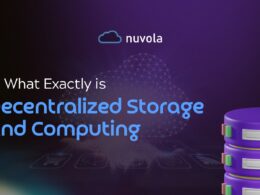Cryptographer David Chaum first proposed a blockchain-like protocol in his 1982 dissertation “Computer Systems Established, Maintained, and Trusted by Mutually Suspicious Groups.” In its first steps, blockchain technology had with Bitcoin, 13 years ago, its utility application as a payment system, explained in its Whitepaper “Bitcoin: A Peer-to-Peer Electronic Cash System”.
Decentralized finance (DeFi), in its evolution, has occupied a predominant place for second generation blockchains (such as Ethereum) and third generation (such as Cardano), with smart contracts, that is, encrypted agreements that run on the network automatically. automated.
People do not need to go through any private company, such as PayPal, Western Union, or a bank, to send, borrow, or lend money. Generally speaking, the fees and financial cost tend to be significantly lower.
The sector has experienced exponential growth, which is now estimated at more than USD 200 billion of Total Value Locked (TVL), that is, money that is applied in smart contracts, according to data from the platform https://defillama.com.
Traditional consumer credit and finance profiles personal credit risk, based on analysis to understand how borrowers behave: how much they spend, their income, etc. A mature credit scoring system is key to granting credit in developed economies, but is even more necessary in emerging markets, and banks often turn down loans because they don’t have enough data on who is borrowing.
DeFi’s approach to risk mitigation is different. Lacking a system for evaluating the debt taker, it simply requires a collateral guarantee deposit, which will be executed in the event of non-payment of any of the loan installments.
An extreme case of this type of financing is flash loans, which work like an instant loan that does not require collateral, where the repayment of the borrowed capital must be made within the same block in which it is lent, otherwise the initial transaction is rejected. This type of loan is speculative where you try to earn a spread with the borrowed cryptocurrency, and has little to do with a commercial application in the real economy.
Today, as the DeFi system is structured, it is useful for those who have a thorough knowledge of blockchain technology. The system is incomplete, since it does not fulfill its total objective. Those who access financing are actors who are accustomed to the world of finance, and consider this new tool as yet another vehicle for their investments.
Given how the complex system is structured, it is difficult for a farmer or a small service entrepreneur to take out a loan for their business.
In order to democratize DeFi, the identity of borrowers is necessary. Build a credit score by consulting identity-linked proxies such as utility companies to verify payment behavior. There is an identity and a reputation, the problem is how to link the data to the identity, starting from the decentralized identity, automating its use in smart contracts. The privacy and security of the data of its holders is a greater challenge.
RealFi, the Next Step of DeFi
Cardano’s mission is to build RealFi, (real finance) that is, “real” finance aimed at people who really need new ways to access finance, creating that “real” value that is often missing in DeFi.
RealFi is an ecosystem of products that removes friction between crypto liquidity and real world economic activities to offer attractive returns to crypto holders and cheaper credit/financial products for real use in the economy.
Smart contracts need information from the real world, and for this they use oracles, which are external, reliable data sources, with information outside the chain, such as the weather, election results, cryptocurrency prices, or commodity etc.
It is important to remember that the blockchain is not here to resolve all kinds of disputes. If only digital assets are at stake, there is no need for a legal system, the smart contract will execute the defined conditions. But when the contract exceeds digital assets, the intervention of the judicial authorities will be necessary.
People sometimes mistakenly believe that everything related to blockchain technology should be completely anonymous and independent from the outside world. Without the interconnection of the physical and digital worlds, we cannot create the necessary stability for finance and it would only remain speculative and marginal businesses.
Identity promotes fair lending. A good credit reputation allows you to take credit at fair rates.
The transfer of funds from developed countries to developing countries can really help people a lot to change their living conditions. And this is achieved with decentralization. RealFi heralds the arrival of a new global era of financial and social inclusion for Africa and countries with the greatest needs.
Speculation and Stability
The Blockchain is an excellent tool to create a global financial infrastructure, and it fits perfectly in the world of finance, but the volatility of its native currencies have little use for that purpose. The blockchain needs economic incentives to work.
If cryptocurrencies had a stable value, there would not be as much demand for them for speculative gain.
There is its strength and its weakness, at the same time.
The key is to understand and differentiate cryptocurrency as the fuel of your blockchain. Their consensus does not matter, which can be PoW or PoS, where both encourage, although in different ways, but they do, rewarding participation in the network with tokens.
Only on stable media of exchange can a solid RealFi system be built. It is difficult to find an economic factor in the world that can keep its value stable on its own. This is because many phenomena are interconnected, and this constantly changes supply and demand. Gold stability is expected, but even its value fluctuates slightly depending on the short-term market mood.
Those monetary means are stablecoins, because a fungible token that represents a value needs stability to be a unit of measure.
Stability is likely to be reached only through a controlled process derived from a basket of commodities and stablecoins. For example, with stabilization algorithms or issuance backed by reserves.
In an article I have written, you can read about stablecoins on Cardano: The Stablecoin Ecosystem Being Built on Cardano.
The Cardano infrastructure is the fundamental pillar for RealFi development, but if agreements with companies and governments are not fostered, the evolution would be much slower. In a future article I will analyze the actions that IOG, the global subsidiary of IOHK, developer of Cardano, is carrying out so that the blockchain takes the next step.










